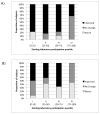Text Messaging Improves Participation in Laboratory Testing in Adolescent Liver Transplant Patients
- PMID: 26213633
- PMCID: PMC4511378
Text Messaging Improves Participation in Laboratory Testing in Adolescent Liver Transplant Patients
Abstract
Background: In solid organ transplant patients, non-participation in all aspects of the medical regimen is a prevalent problem associated with adverse consequences particularly in the adolescent and young adult (AYA) age group. This study is the first to evaluate the feasibility, utility and impact of a text messaging (TM) intervention to improve participation in laboratory testing in adolescent liver transplant patients.
Methods: AYA patients, aged 12 to 21 years, were recruited for a prospective pilot trial evaluating a TM intervention delivered over a 1-year period. The intervention involved automated TM reminders with feedback administered according to a prescribed laboratory testing frequency. Participation rate in laboratory testing after the intervention was compared to the year prior. Patient responses and feedback by text and survey were used to assess feasibility, acceptability and use of the intervention.
Results: Forty-two patients were recruited and 33 patients remained enrolled for the study duration. Recipients of the TM intervention demonstrated a significant improvement in participation rate in laboratory testing from 58% to 78% (P<.001). This rate was also significantly higher than in non-intervention controls (P=.003). There was a high acceptability, response rate and a significant correlation with reported versus actual completion of laboratory tests by TM.
Conclusions: TM reminders significantly improved participation in laboratory testing in AYA liver transplant patients. The intervention demonstrated feasibility, acceptability, and use with a high proportion of patients who engaged in and perceived a benefit from using this technology.
Keywords: HIT; Liver Transplant; Participation; Self-care; Self-management; Text-messaging; adolescents; mHealth; mobile health.
Conflict of interest statement
Conflict of interest: The authors have no conflicts of interest to disclose.
Figures



References
-
- Finn NB. Addressing the problem of medication non-participation. J Participat Med. 2014 Oct 10;6:e13.
-
- Cheng J, Walter E. Non-adherence in Pediatrics. In: Bosworth HB, Oddone EZ, Weinberger M, editors. Patient treatment adherence: concepts, interventions, and measurement. Lawrence Erlbaum Associates, Inc; New Jersey: 2005. p. 239.
-
- Berquist RK, Berquist WE, Esquivel CO, et al. Adolescent non-adherence: prevalence and consequences in adolescent liver transplant recipients. Pediatr Transplant. 2006;10(3):304–310. - PubMed
-
- Burra P, Germani G, Gnoato F, et al. Adherence in liver transplant patients. Liver Transpl. 2011;17(7):760–770. - PubMed
-
- Dobbels F, Van-Damme-Lombaert R, Vanhaecke J, De Geest S. Growing pains: non-adherence with the immunosuppressive regimen in adolescent transplant recipients. Pediatr Transplant. 2005;9(3):381–390. - PubMed
Grants and funding
LinkOut - more resources
Full Text Sources
